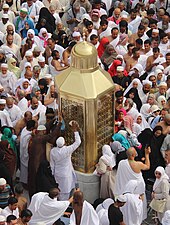Maqam Ibrahim

The Maqām Ibrāhīm (Arabic: مَقَام إِبْرَاهِيْم, lit. 'Station of Abraham')[1][2] is a small square stone[3] associated with Ibrahim (Abraham), Ismail (Ishmael) and their building of the Kaaba in what is now the Great Mosque of Mecca in the Hejazi region of Saudi Arabia. According to Islamic tradition, the imprint on the stone came from Abraham's feet.[4][5] It is the only standing historic structure in the Mataf area out of at least six other, which were removed to clear the area for the circumambulation (tawaf).[6]
Formation
[edit]According to one tradition, it appeared when Ibrahim stood on the stone while building the Kaaba; when the walls became too high, Ibrahim stood on the maqām, which miraculously rose up to let him resume building and also miraculously went down in order to allow Ismail to hand him stones.[3] Other traditions held that the footprint appeared when the wife of Ismail washed Ibrahim's head, or alternatively when Ibrahim stood atop it in order to summon the people to perform the pilgrimage to Mecca.[7]
The stone
[edit]
The stone inside the casing is square shaped and measures 40 cm (16 in) in length and width, and 20 cm (7.9 in) in height.[3] It used to be enclosed by a structure called the Maqsurat Ibrahim which was covered by a sitara: an ornamental, embroidered curtain that was replaced annually.[8] Currently, it is placed inside a golden-metal enclosure. The outer casing has changed a number of times over the years; historic photographs show that the arch of the Banu Shaybah Gate stood next to it.[9]
See also
[edit]References
[edit]- ^ Quran 2:125
- ^ Quran 3:97 (Translated by Yusuf Ali)
- ^ a b c "Maqam Ibrahim (Station of Abraham)". Madain Project. Archived from the original on 9 September 2020. Retrieved 9 September 2020.
- ^ Peters, F.E. (1994). "Another Stone: The Maqam Ibrahim". The Hajj. Princeton, New Jersey: Princeton University Press. pp. 16–17. ISBN 9780691026190.
- ^ "Maqam-e-Ibrahim shines ... like visitors' faith". 25 September 2016.
- ^ "Mataf". Madain Project. Archived from the original on 17 June 2024. Retrieved 9 July 2024.
- ^ Kister, M. J. (1991). "Maḳām Ibrāhīm". In Bosworth (ed.). The Encyclopaedia of Islam. Vol. VI (Mahk-Mid) (2nd ed.). Brill. p. 105.
- ^ Nassar, Nahla (2013). "Dar al-Kiswa al-Sharifa: Administration and Production". In Porter, Venetia; Saif, Liana (eds.). The Hajj : collected essays. London: The British Museum. pp. 176–178. ISBN 978-0-86159-193-0. OCLC 857109543.
- ^ "Bab Bani Shaiba". Madain Project. Archived from the original on 9 September 2020. Retrieved 9 September 2020.
Further reading
[edit]- Kister, M.J. (1971). "Maqām Ibrāhīm: A Stone with an Inscription". Le Muséon. 84: 477–491.
21°25′21″N 39°49′35″E / 21.42262°N 39.82633°E

